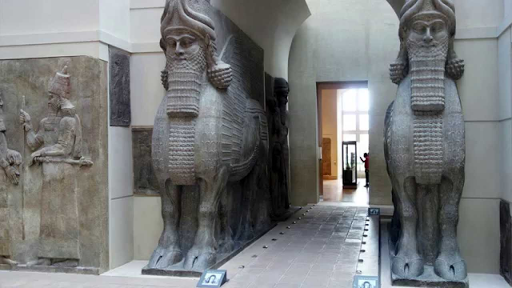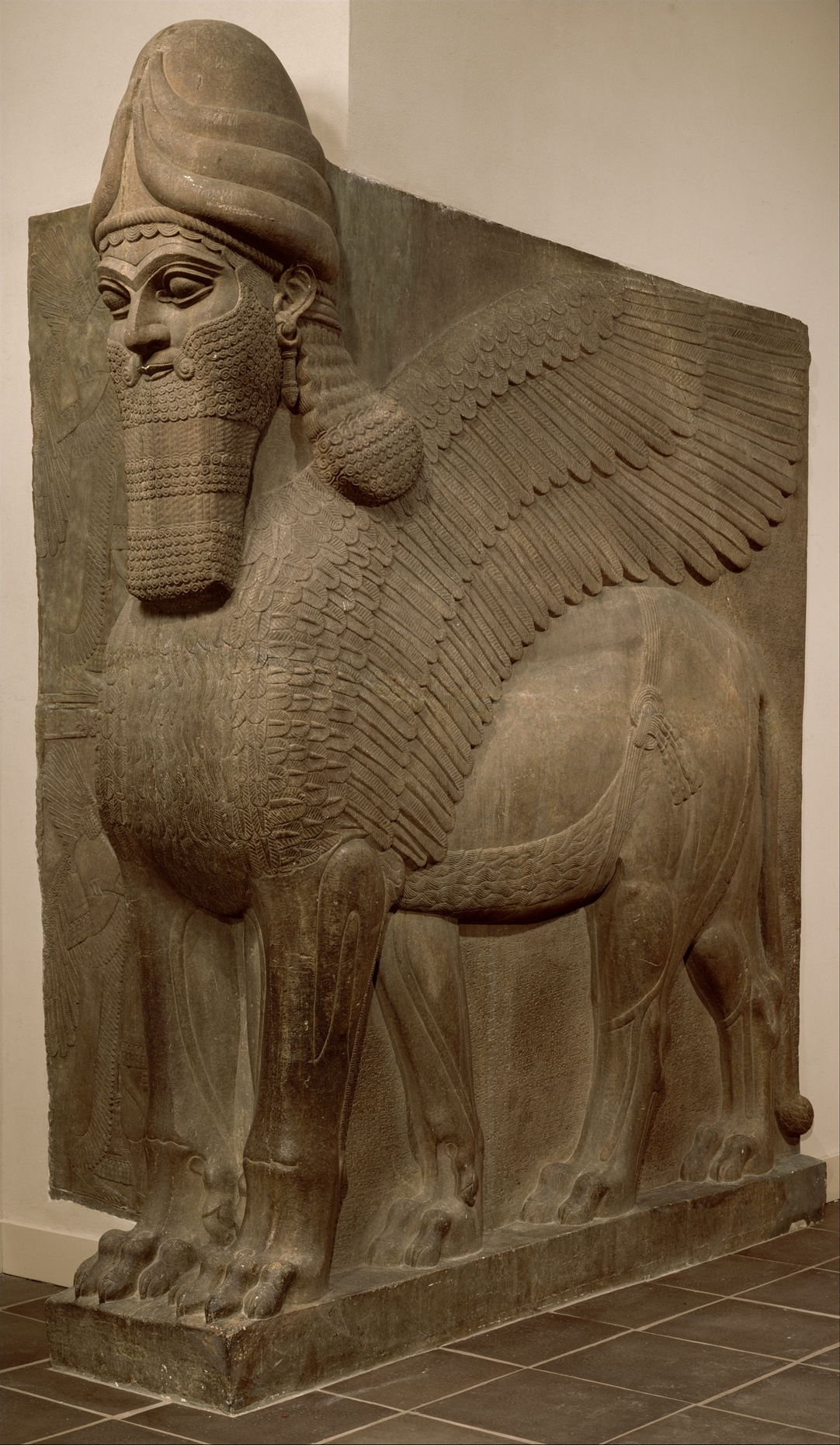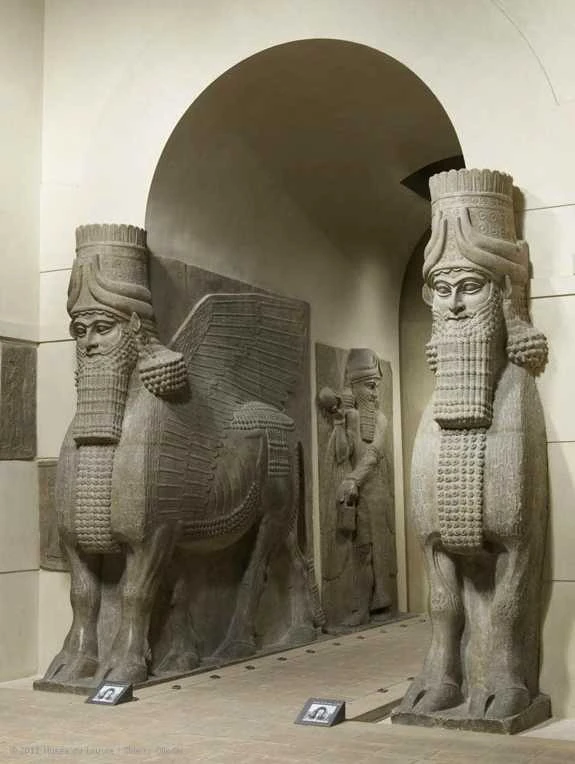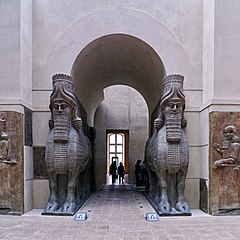In the Assyrian mythology there were human headed winged bullslions that were protective genies. For this reason it is not an entirely freestanding sculpture.
The Lamassu seen from the side from the palace Sargon II r.

. Originally unearthed in Rome and displayed in the Borghese Gallery it was sold to the occupying French and now sits in the Louvre. A Sargons palace b Gudeas Lagash c Ashurbanipals palace d Ziggurat at Ur Which of the following played an important role in the shaping of modern art. Lamassu were placed on either side of the doorways of Assyrian palaces and of gateways to cities to protect against evil spirits and impress the neighbors.
The Ziggurat at Ur was a fortress funerary monument palace temple platform Where were the Lamassu sculptures originally displayed. Originally unearthed in Rome and displayed in the Borghese Gallery it was sold to the occupying French and now sits in the Louvre. The first change was the capital was moved to Dur Sharrukin present day Khorsabad and second the Lamassu was presented on a bulls body compared to a lions and seems to be slightly smiling.
It is 3112cm tall 622cm wide 2769cm long which is even larger than the sphinx and is displayed at the Metropolitan Museum with the similar-sized. It comes from Mesopotamia and is believed to be created in ca. What ethnic group is credited with the first system of writing known to man.
The British Museum was the first public national museum in the world. The winged beasts from Nimrud in Iraq the ancient city of Kalhu also became quite famous when Lamassu there were ruined in 2015. The most famous colossal statues of Lamassu have been excavated at the sites of the Assyrian capitals established by King Assurnasirpal II reigned 883 859 BCE and King Sargon II reigned 721 705 BCE.
What ethnic group is credited with the first system of writing known to man. Assyrian sculpture typically placed prominent pairs of lamassu at entrances in palaces facing the street and also internal courtyards. The Ziggurat at Ur was a fortress funerary monument palace temple platform Where were the Lamassu sculptures originally displayed.
The gate and its lamassu were first excavated by Sir Austen Henry Layard in 1849 but then re-buried. The Lamassu sculptures were recovered from where. The Ziggurat at Ur was a fortress funerary monument palace temple platform Where were the Lamassu sculptures originally displayed.
What ethnic group is credited with the first system of writing known to man. What color is lapis lazuli. Where were the lamassu sculptures originally displayed.
Where were the lamassu sculptures originally displayed Written By viveiros Friday March 11 2022 Add Comment Edit Terracotta artwork was the standard for decorating the superstructure of Etruscan temples and the coroplastic terracotta workshops producing these sculptures often displayed a high level of technical achievement. This replica was made with 10000 Iraqi date syrup cansand serves as a symbol of. What were the most common themes in Assyrian art.
Click to see full answer Furthermore where were the lamassu sculptures originally displayed. Colossal Lamassu Sculpture From The Palace Of Sargon Ii At Khorsabad Sargon Ii Google Arts Culture Human Headed Winged Bull Lamassu Assyrian Neo Assyrian The Metropolitan Museum Of Art Share this post. The first change was the capital was moved to Dur Sharrukin present day Khorsabad and second the Lamassu was presented on a bulls body compared to a lions and seems to be slightly smiling.
The Ziggurat at Ur was a fortress funerary monument palace temple platform Where were the Lamassu sculptures originally displayed. The Lamassu sculptures were recovered from where. 721-705 BCE Part of a collection at the Louvre in Paris France.
These massive sculptures served as symbolic guards of Assyrian kings domain being placed at the entrance to both the city and palace gateways See Collins 2008 72. The winged beasts from Nimrud in Iraq the ancient city of Kalhu also became quite famous. The most famous colossal statues of Lamassu have been excavated at the sites of the Assyrian capitals created by King Assurnasirpal II reigned 883 859 BC and King Sargon II reigned 721 705 BC.
They were represented as double-aspect figures on corners in high relief. However it is displayed in a museum in its original context a lamassu is the guardian of a doorway integral with a wall. Which work has a king approaching the god Shamash.
An American professor named Michael Rakowitzwas commissioned to recreate this Lamassu sculpture and it is now displayed in Trafalgar Square in London. The Assyrians envisioned a protective spirit that was part bull and part human and sometimes part eagle. The Lamassu sculptures were recovered from where.
In some cases the lamassu statues were accompanied by. It documents the story of human culture from its beginnings to the present. Human-headed Winged Lion is a raised relief sculpture of a Lamassu with the body of a lion made of gypsum alabaster.
From what we can tell it seems that these sculptures were believed to protect the palace and king from evil supernatural forces as well. Originally unearthed in Rome and displayed in the Borghese Gallery it was sold to the occupying French and now sits in the Louvre. Hermaphroditus was actually a popular subject of paintings and statuary even if Written By whitehouse March 11 2022 Add Comment Edit.
Appreciating and understanding ancient Egyptian art. Where were the Lamassu sculptures originally displayed. Lamassu the were.
Which work has a king approaching the god.

Lamassus At The Louvre Thatmuse

Lamassu From The Citadel Of Sargon Ii Video Khan Academy

25 Lamassu From The Citadel Of Sargon Ii Dur Sharrukin Modern Iraq Ap Art History

Human Headed Winged Lion Lamassu Assyrian Neo Assyrian The Metropolitan Museum Of Art
Human Headed Winged Bull Lamassu Assyrian Neo Assyrian The Metropolitan Museum Of Art

Lamassu History 2701 Wiki Fandom
Colossal Lamassu Sculpture From The Palace Of Sargon Ii At Khorsabad Sargon Ii Google Arts Culture


0 comments
Post a Comment